
February 23, 2013
 CR Sunday Interview: Richard Sala
CR Sunday Interview: Richard Sala


*****
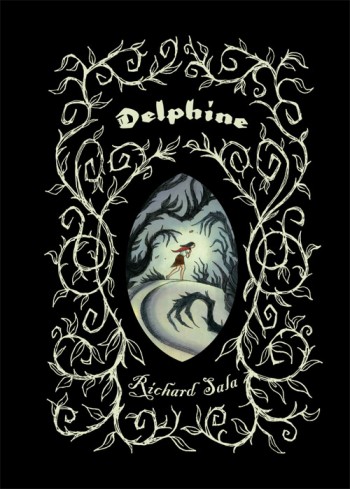 Richard Sala
Richard Sala is one of the best artists to have worked in comics the last three decades and one of the most underrated cartoonists generally. He may be better known for the general look and feel of his work than for any specific comics effort, which is understandable given how strongly the horror, fairy-tale, kids-adventure elements of his comics communicate. Sala is the kind of cartoonist around whom one builds cults except for the fact that he's never stopped working. In fact, his latest run of books may be his strongest: from the series
Evil Eye now some 10-15 years behind us to much more recent efforts like
Cat Burglar Black and
The Hidden.
Sala's latest is a collected, hardcover version of
Delphine, his series with
the Ignatz line of oversized, high-production, intermittent-but-serial comic books done by an assortment of publishers with
Coconino Press and
Fantagraphics leading the way. Like all of Sala's recent work it's tightly structured and full of odd, affecting set pieces. It's also flat-out gorgeous. I was delighted he took some time to me. I wanted to talk to him a while back about
The Hidden, but personal circumstances on my end got in the way -- please forgive my curiosity in the direction of older work during what follows. One of my fondest hopes for this age of arresting imagery and passed-around moments is that the comics world learns to appreciate Richard Sala that much more than it does already. -- Tom Spurgeon
*****
TOM SPURGEON: Richard, I don't have a sense of how you work, particularly how much time you spend on comics in a week/month/year, how long it takes you to work. Can you talk about that a bit, just how much of your professional life involves comics and where it sits in the general constellation of what you do?
RICHARD SALA: It's a good question, but it's kind of hard to answer since comics are just a part of the stew. I'm always working on something, usually trying to juggle several projects, so it all depends on which deadline is closest. With comics I often have to make up my own deadlines. You especially have to do that these days, since it's all about graphic novels instead of a series. It was a lot easier to set up a deadline to finish 24 pages every couple of months when I had my series,
Evil Eye. Somehow that was more palatable and conceivable. Nowadays, I'll write big reminders on my calendar. I guess it helps that I've always been pretty motivated and enjoy doing it.
These days there's the option of doing a serialized comic online. I've been working on a couple of ideas for that, but it's a serious commitment, so I want to be sure it's a good idea. In the meantime, to sort of test the waters, I started doing these themed exhibitions of my work online. I actually do those in a serial format. New work is posted once a week, with a set, finite number of pieces, so that it would last maybe a month or two. When all the work for a series has been posted, they stay up as individual online exhibitions.
The first series was "
Unmasked," which was something I did for Halloween a few years ago. That was a group of portraits of various creatures and monsters, based on my childhood memories of monster masks. I had been doing new work every Halloween for several years, posting those online. But because I was doing so many of these small portraits, I would release a few new ones every few days during October, and I found that serial format really appealing.
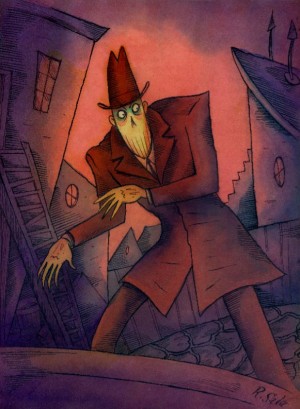
So I got more ambitious and did a series called "Skeleton Key." For that, I released 40 character portraits, each accompanied by kind of fanciful biographical information, every week for about three months. The sub-title was "A Secret History" because it was a guide to characters who have appeared in my work in various places over the years, but I was also revealing new details about them. like background information or hints of other adventures that aren't anywhere in the actual books. I even included several new characters who aren't in any of my books at all and some who are but are only minor characters and gave them all these sometimes elaborate backstories. There's some crossover with a lot of these characters, so I was playing with the concept of creating a guide to my very own fictional universe. I mean, it was totally tongue in cheek but at the same time I was pretty serious, if that makes sense. I have a fatherly affection for these silly characters and their worlds. Plus, believe it or not, I had always wanted to do something along the lines of Borges' "Universal History of Infamy" which I read years ago and which made a big impact on me. But if that sounds too snooty, I was also inspired by bubblegum cards, the kind with the picture on the front and the description or bio on the back. There was a series I had as a kid called "Pirates Bold" that I was particularly fond of, because you got a cool portrait on the front and on the back you could read about their horrible, bloody lives. For the portraits themselves, I kind of imagined those as old Aurora model kits from the 1960s, in which you'd have the full figure of a character in their environment frozen in a cool pose. Anyway, this was something I did primarily for my own enjoyment, but I got nice, encouraging reactions from people who like my work. To be honest, while I was working on it, I'd have these moments where I felt almost like an outsider artist in his own little deluded world -- like, do these characters even mean anything to anybody but me? But I ended up hearing from more people than I ever expected to who seemed to enjoy it -- which was was gratifying and encouraging.
I set up
a separate gallery for the complete Skeleton Key work which you can read in order here.
The portraits for that series were pretty small, only around 9" x 12". For the next series, I wanted to do larger, more elaborate work. I came up with "Autumn and Evil," which was that old artists' stand-by, the alphabet. That consisted of 26 watercolor and ink drawings featuring homages to classic genre situations and characters.
I've got
The Autumn and Evil series set up on my tumblr so it can be viewed in alphabetical order here.
For years it was frustrating that I couldn't get my color work properly into print. Either the reproduction would be horrible or (as far as comics went) it wasn't economically viable. I'm glad I lived long enough to be able to do more color work and have a place where people can see them.

I love working in watercolor because it's all about trusting your abilities and having the confidence to let happy accidents happen. You can't make major corrections with the kind of watercolor and ink drawings I do. You can make changes later in photoshop if you want to, and you can make small changes by touching up very carefully with gouache. But it's always a bit of a tightrope. Also, I'm not one of those famously fastidious cartoonists who are very careful with every line. I'm kind of a fuck-up, actually. I can barely get measurements right even when I'm using a ruler. I've appalled fellow cartoonists when they see me pull out a Dixon Ticonderoga #2 lead pencil and a pink eraser instead of whatever expensive tools they're using. My watercolor palettes are caked with years of dried paint, which I can bring back to life like magic with water.
Tip: Always squeeze out the entire tube onto your palette; even if you don't use much of that color initially, it will be available to use for years! Plus, never, ever clean your palettes off, it's a total waste! Buy more palettes before you clean old ones.
For most of my inking I use a nib that's not even intended for the kind of work I do -- a Hunt 108 which I think is designed for fancy script lettering -- because after spending years looking for the right tools, that nib gave me what I wanted. I can get an elegant line of varying width while still being able to press down hard if I want to, like I'm making incisions. Then I love to splash watercolor on my dried ink drawings and watch the puddles of colors mingle and blend together. There's always a chance that I might ruin the drawing beyond any repair, but I like the challenge and the rush of energy I get trying to make it work.
So yeah, I'm glad I can show off my color work online in ways I never could have otherwise. I never expected the internet to become as much a part of my life and art as it has. I guess that's something only someone who remembers life before the internet would say. It's so great to be able to check in on colleagues -- on
Facebook or whatever -- and see what they're up to while I have my morning coffee. I feel a kinship with other working artists. I go way back with some of them and others I've never met, but I love hearing about what they're working on. It can be inspiring. I like checking out new work by younger artists, too, and I'll wonder if it would be creepy to comment and tell them when I think their art is cool or if I like something they said. In fact, it is creepy and I shouldn't do it, but sometimes I forget that until after it's too late.
Anyway, I know things can change fast these days, so I'm just enjoying the opportunity to display my color work online for now for whoever wants to see them. At a certain point we'll probably do a print collection, so they may not stay up forever, I don't know. As much as I like being able to display my work online, I'm still a book lover at heart.
So, anyway -- that's sort of an overview of where things are right now. It won't be long before I do another online project. And I'll have a new book from Fantagraphics some time in 2014 or early 2015, hopefully. But it's too early to talk about any of that.
 SPURGEON: I want to focus mostly on
SPURGEON: I want to focus mostly on Delphine
, but it struck me you've had a number of books the last five years or so, you've been as productive as anyone. I'm hoping I can get two or three questions in on those books I was wondering what you thought about the work you did in Cat Burglar Black
now that you're a few years removed from it? I thought the art in that was almost luminous, the colors were so pretty. Were you happy with the way that one turned out. Cat Burglar Black
also seemed a really interesting publishing partnership for you, with First Second and their interest in all-ages books, or at least books with those kind of classic kids-literature hooks. I haven't talked to a bunch of their authors; was that a positive experience, different than some of your classic alt-comics publishing experiences in any way you can recall? Are you still working with them?
SALA: With
Cat Burglar Black, I was aware that something specific was expected of me. That is, Fantagraphics is usually very tolerant of whatever silly concept I throw at them, they just want me to be me. With First Second, I felt I had a responsibility to deliver something more blatantly commercial. I was grateful I'd been given that chance and I didn't want to let anyone down. But, in the end, even though I tried my best, I guess I did let them down. I mean, I had hoped to do a sequel where I could tie up loose ends, and then maybe develop things to the point where we'd have a series of books with those characters. That had been part of the discussion from the very beginning. I recall talking with one of the editors during the initial pitch about the French character
Fantomette, and we discussed how cool it would be to create an on-going series in the US like
Fantomette is in France. But that didn't happen, although I'm still not entirely sure why it didn't. I mean, I'm not trying to sound naive. Sometimes things just don't work out. I asked if the sales had been disappointing and was told they weren't. But maybe they were just being nice, who knows.
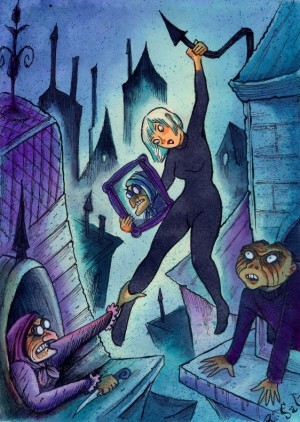
The process wasn't my ideal way of working. I had to type up a complete script and get it approved before I could draw a single line. I don't think that's the way most cartoonists work. Our scripts are often like storyboards, right? The process of having to write out a description of a place or a character or an action that could easily have been depicted in a sketch made things needlessly complicated and time-consuming. But I was part of the very first batch of artists who signed on, so maybe it's changed since then, I don't know. Or maybe some cartoonists just stand their ground and tell them that's not the way they work. They didn't listen to me when I said that, though, it just wasn't negotiable. They had to see a finished script first.
Then, the first editor I was assigned was a freelancer, not someone on staff, and that was a bit of a bumpy ride, mainly because he wasn't always as available as I would have liked. Just going back and forth with the changes to the script took months, which was frustrating. I had been ready to work on it non-stop, but weeks would go by and I wouldn't hear from him so nothing would get done. My book was clearly not a priority in his life -- which is fine, but it was just so inefficient. I wrote to First Second a few times because I was concerned about losing so much time, and they insisted I had to go through this process. My proposal was accepted in November 2004 and it wasn't until May 2007 that I was told that the script was done I could finally start on the "visuals." Over two years on the script alone, not one drawing allowed, with maybe ten actual revision requests from the editor, and less than twenty emails altogether. Not to mention that it made my relatively low advance seem like a bit of a joke. But I guess my experience wasn't unusual.
Anyway, at that point I was handed over to a staff editor at First Second, and even though we had to go over the entire script again, at least the wheels were finally turning. But because getting that initial script approval had taken so long, and we had fallen so far behind, I had to rush on the art much more than I would have liked. I still can't look at some of the pages. A lot of them were completed in photoshop to save time, which I've never done before or since. Some of the pages of original art are filled with mistakes that I corrected on the scans, so it would be too embarrassing to show them or try to sell them, and I had been hoping to be able to sell the art. But we finished the thing and they did a nice job with the design -- an amazing job actually by
Colleen AF Venable. And
Gina Gagliano, who did the marketing, was also very kind and helpful.
But -- maybe that had something do with why we didn't do a sequel? Like -- because I had complained a couple of times about the process? I don't know. When you're neurotic you can't stop wondering about things that seem either obvious or insignificant to other people, I guess. And if someone seems sphinx-like and unforthcoming to you, it may simply mean that they have no interest in you whatsoever. It's like when you ask a friend about what other people think of you: "Are they saying awful things about me?" "No, they never even mention you at all."
I looked at the other books they've been releasing and most seem to be drawn in that style of the generation influenced by modern Disney movies and anime. That's pretty foreign to me (although I understand being influenced by stuff from your youth -- I am, too). They also seem really slick, with any personal stylistic idiosyncrasies kind of ironed out. So maybe that had something to do with things not continuing -- just a stylistic gap that was too wide and I couldn't provide the look they wanted. But then I see they're publishing a Matt Kindt book in hardcover. So, I don't know. At some point you have to admit to yourself that you can't be everyone's cup of tea and move on.
The heroine's backstory was pretty dark, more like
Dickens than
Disney. It was important to me that there would be actual danger, where characters might be hurt or be killed. There was some questioning of that, of course. But I didn't want to write about a gang of thieves where everyone is happy and safe and there are no consequences for seriously dangerous behavior. And I don't think kids want that either. I certainly didn't. I liked reading things that seemed intense when I was a kid. I liked that I could handle it. Anyway, some of the darker stuff was there as a hook for the sequel, where people who it seems might have come to bad ends actually didn't.

The sequel was going to revolve around the heroine discovering that the entire town near the school -- where her friends disappeared -- has been designed as a haven for criminals in hiding, with tunnels connecting the houses. She meets a kindred spirit in one of the houses she breaks into, a lonely kid who helps her solve the mystery of the town and it's residents. And she finds that at least one of her friends is not only alive, but has joined up with the bad guys and they're now on opposite sides, so there's some conflict and heartache. I don't know, maybe it's better off ending where it did. But anyway, First Second and I did the whole "first refusal" thing, where I asked if they were interested and they weren't -- so the rights to a sequel officially reverted to me. So I could still do it, I suppose. But as the years go by it seems less and less likely.
Speaking of things that are troubling and that artists now have to worry about apparently, this was my first encounter with something called a "no-fee option" from Hollywood. It's really insidious, because traditionally an option from Hollywood is something a creative person hopes for. You're paid a fee to give them the right to look into making a movie of your work over a set amount of time, even if they never do. And after that set amount of time, which is usually a year I think, if they want to renew the option, they have to pay you again. At least one well-known cartoonist famously lived off the annual renewed options on his work for a movie that was never made, so the story goes, and he probably wasn't alone. First Second was representing the movie and TV rights for
Cat Burglar Black and I got an e-mail saying that someone in Hollywood wanted to take out a short-term, no-fee option. I'd never heard of that before. It meant that they would only have the option for three months, with no option to renew it. I was told that this was actually a good sign because it indicated that they were very serious and a sale was virtually guaranteed. So I agreed to it. What the hell did I know? Of course, nothing ever happened. After the three months had passed, I wrote First Second several times to find out if indeed the option had been returned to me, since I figured I should make sure they hadn't been able to renew the option for free, and I just wanted to find out if anyone could tell me anything else about what happened. Some people promised to look into it, but never got back to me. Finally I realized how pointless and naive it was to keep asking about it. You feel like a pathetic pest. And that was that. I never heard another word about it. So some producer was able to take out an option on my book and presumably shop it around without having to pay a cent. Anyway, just another thing to drive artists crazy.
SPURGEON: The Hidden
is an incredibly brutal piece of work, and one that I know my friends have talked about as a book that maybe didn't get the attention it deserved. There's a real element to your later works where the horror of these kind of relentlessly hopeless situations is played up, and I think that may get its best workout here. Do you modulate at all the scenarios you depict, does how distressing a situation you're depicting weigh on you at all? It also strikes me you might have a different opinion on that work altogether.
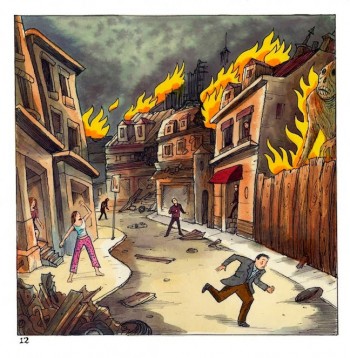 SALA:
SALA: Yeah, I guess I needed to get back to something violent and nihilistic. I wanted to do my take on an end of the world horror story, but somehow make it unique. I suppose I could have done another version of a zombie apocalypse, and maybe that would have been easier to sell. But the kind of end of the world stories that are the most memorable to me are the ones where there was a mystery about what had happened and why. That can add to the sense of disorientation. Then when the truth is revealed it can be a bit of a shock. There's not much mystery left in zombie apocalypse stories. They seem to have evolved more into the adventure genre than horror.
In
The Hidden, the reader gets information late in the story that explains the mystery and it's supposed to be a bit of a surprise. There is a well-known, classic character behind everything, but I never come right out and say it. I allow the reader to connect the dots. Some reviews gave it away in their first line while others were really discreet about it, but I don't think it mattered either way. It doesn't wreck the experience of reading it if you know it going in, I don't think.
As for whether depicting violent scenes may weigh on me -- it's more like I'm exorcising demons, as cliché as that sounds. I mean, you feel somewhat conflicted, but there are primal forces at work. There are dark thoughts fighting with all the reasonable ones, something to do with my Italian roots maybe, or something from childhood, rising out of abuse or repression. And for the reader, the violence may provide a safe catharsis. At least it always felt that way to me. I also wanted to say something sort of political in this book, in kind of an angry way, so that meant pushing the boundaries a bit. There's nothing worse than seeing hope or innocence destroyed by forces that truly don't care.
All that being said, I've certainly seen comics that are much more violent than mine. Plus I imagine that maybe the way I draw makes violent scenes somewhat easier to take, although it's hard for an artist to see their style the way others see it. I guess it's ultimately an individual threshold, the tolerance for what kind of and how much violence you want to see. For every person who thinks my work looks too bloody, there's another who thinks it's not bloody enough.
SPURGEON: Do you feel it found its audience?
SALA: I don't know. I've learned over the years to be much more patient about that. I've never been one of those cartoonists whose books are read and reviewed as soon as they're released. No one is telling anyone that they
have to read my books. But somehow people seem to find my work, eventually. I have a relatively small audience, I guess, but they seem enthusiastic and devoted. And with each new book, new readers go back and buy my older books, or so I'm told. I get letters from readers who have only recently discovered me all the time. Reviews will trickle in over months. I'll get really thoughtful reviews of books that came out years ago. That actually makes me feel more like I'm a part of the big picture, the big sea of books -- it's kind of comforting. I feel like it points to the possibility that people will continue to discover my books long after I'm gone and that's kind of gratifying.
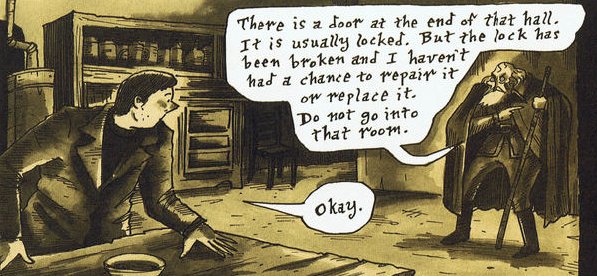 SPURGEON:
SPURGEON: Delphine
got its start as one of the books in the Ignatz line, which was an admirable partnership by Fantagraphics and a number of European publishers, I think spearheaded by Igort. I know almost nothing about how that group of comics came about from the creators' perspective. How were you approached? Were you edited? What was that experience like?
SALA: As I recall, the word went out from Fantagraphics that this partnership was going to happen and artists were encouraged to submit ideas. I don't know how it was for anyone else, but I wrote up a proposal, which -- I'm slightly embarrassed to say -- included the line that has been used to advertise
Delphine to this day: "A modern version of
Snow White as told from the point of view of the prince." That line in the solicitation for the first issue in the Diamond distribution catalog was high concept enough to get Hollywood calling, believe it or not. I had a number of very flattering conversations with genuine Hollywood people about it, but my schedule was way too slow for them. They had no intention of waiting two years for me to finish the thing. And sure enough, before my last issue came out, Hollywood was swimming in
Snow White and fairy tale re-imaginings.
SPURGEON: To back up a second, Richard, I don't even know what your penetration is into European comics. Have you been publishing over there all along? What's your non-English language readership like?
SALA: I don't how how much penetrating of the European scene I've managed to do either, actually. I leave that up to my publishers, I guess. I know there was a very handsome French version of
The Chuckling Whatsit from Vertige Graphic which was titled
Un Rire Dans La Nuit. There were Spanish versions of my two
Peculia books, I think. I know I have a following in Europe, but most of those readers own the English language versions of my books.
 SPURGEON: Part of the design with the Ignatz line was I believe to find a serial comics format that might have enough saturation to send people into specialty shops or to other places that might carry them -- I think of Evil Eye as coming pretty late in the run of standard alt-comics. Is there something about doing serial comics that's specifically appealing to you?
SPURGEON: Part of the design with the Ignatz line was I believe to find a serial comics format that might have enough saturation to send people into specialty shops or to other places that might carry them -- I think of Evil Eye as coming pretty late in the run of standard alt-comics. Is there something about doing serial comics that's specifically appealing to you?
SALA: I love doing serial comics. I miss doing them. I've been considering doing a web comic, just so I could experience that again. I like being able to extend the mystery, dropping clues and hints of things to come. Plus it's just so much fun to write cliffhangers!
SPURGEON: Did the format and printing parameters of what the Ignatz line was offering change you approached the work at all? Do those kind of restrictions or limitations ever have an impact on projects for you?
SALA: Not really. Just happy to get the opportunity!
SPURGEON: I don't want to talk about too many of the set pieces in Delphine
, because I don't want to give them away, but I loved the car trip, just because that seems to plug into so many directly specific experience that a lot of us have -- this kind of loss of control being dragged around by someone we don't know. Can you talk about how you develop an idea like that, where it comes from, what's important for you to get down on paper?
SALA: Some of those scenes were exaggerated versions of experiences I've had. You know, we go through life assuming that we are basically decent and reasonable people with good intentions. But then one day you might find yourself in a situation where you have become so frustrated by the unfairness and cavalier cruelty of the world that you feel yourself cracking. You might feel dark waves of primitive rage or misery welling up from somewhere deep inside of you. Loss of control can be really scary. You may find yourself being tested to the extent where you wonder how much you can take before you snap and perhaps become someone else, some darker, crazier version of yourself.
I've been in some situations that were similar to those the guy in the book experiences, where while I was in the middle of it, I suddenly imagined that the worst, most horrible possible outcome was really going to happen. When you're young you can be trusting and reckless and put yourself into unwise situations. I used to hitchhike when I was young, like many in my generation, and sometimes ended up being in some stranger's house. Or I'd be on a trip in the desert with my girlfriend and a bunch of scary bikers would show up. I also once worked a late night shift alone where I had to deal with whoever who walked in the door and there were some very unsettling experiences with crazy people. I wanted to sort of capture that moment when you realize that maybe you shouldn't have been so open and trusting, where your "fight or flight" impulse is going to be tested, a worst case scenario situation.
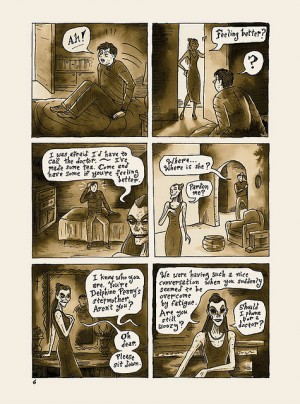 SPURGEON:
SPURGEON: Delphine
features a pretty strong six-panel grid, with most of the variation coming from extending across a single tier or cutting one panel into two. Is the kind of strong rhythm you get out of a sturdy format like that useful in building a narrative. How much do you build your comics in a structural sense and you how much do you let your intuition lead your through the pages?
SALA: It has to be a combination of the two. After I know the basic structure, I can improvise or let my intuition carry me through the writing and rewriting process. But by the time I'm drawing the final art, the story should all be in place. Nobody likes having to throw out completed pages and start again because they suddenly got a better idea. That can happen, but I try to avoid it!
SPURGEON: I read the ending a bit differently than someone I know that also read the book... do you prefer ambiguity at all in terms of how you set up a story, or moments within a story? Are your stories ever intentionally that way, or do you have a specific set of meanings in mind?
SALA: Certainly in some cases ambiguity is intentional, especially if I'm trying to depict a sense of unease. Do I mind if readers of my books interpret things differently than what I intended? No -- that's what makes art interesting. But in most cases there is a very specific intention, about all the important points anyway, and even though things may not be explicitly spelled out, all the clues are there for the reader to put together.
In
Delphine, the protagonist meets a very specific fate. Perhaps I'm just overly comfortable with the language of comics and hoped others would be as well. I mean, I did intend to tease the reader, or fake them out for a moment, but that was only so the realization of the true fate might catch them off guard and seem that much crueler. The story, fanciful though it may be, is completely linear. The narrative, or what the protagonist experiences from beginning to end, is depicted in the panels with square, drawn borders. Along the way, the reader is given glimpses into the protagonist's inner world -- that is, his memories, dreams, fantasies, wishful thinking, delusions -- and those are depicted in panels with soft, cloud-like, non-ruled borders. It's really that simple. But maybe I've just read too many comic books! Perhaps it's kind of a rorschach test and some readers choose to believe in a happy ending? But no, the story is about obsessive love and where that can lead and it's not meant to be pretty. My favorite response was by a writer reviewing the final Ignatz issue when it came out who seemed concerned about me personally, because the ending was so bleak. I couldn't have asked for a better reaction than that!
*****
*
Delphine, Richard Sala, Fantagraphics, 9781606995907, 128 pages, 2012, $24.99.
*
Richard Sala Site
*
Richard Sala Blog
*
Richard Sala Tumblr
*****
* an arresting, over-sized panel from
Delphine
* the cover to the new hardcover
* one of the Skeleton Key character images
* a photo of Sala's workspace pertinent to the discussion of watercolors
* an over-sized panel from
Cat Burglar Black
* the lead to
CBB from the Skeleton Key series
* something labeled as sequel concept art on the Comic Art Collective site
* a typically bleak page from
The Hidden
* an across-the-page panel from
Delphine
* from the original serial packaging of the series
* the six-panel grid
* element from the cover (below)
*****

*****
*****
posted 8:00 pm PST |
Permalink
Daily Blog Archives
November 2019
October 2019
September 2019
August 2019
July 2019
Full Archives


